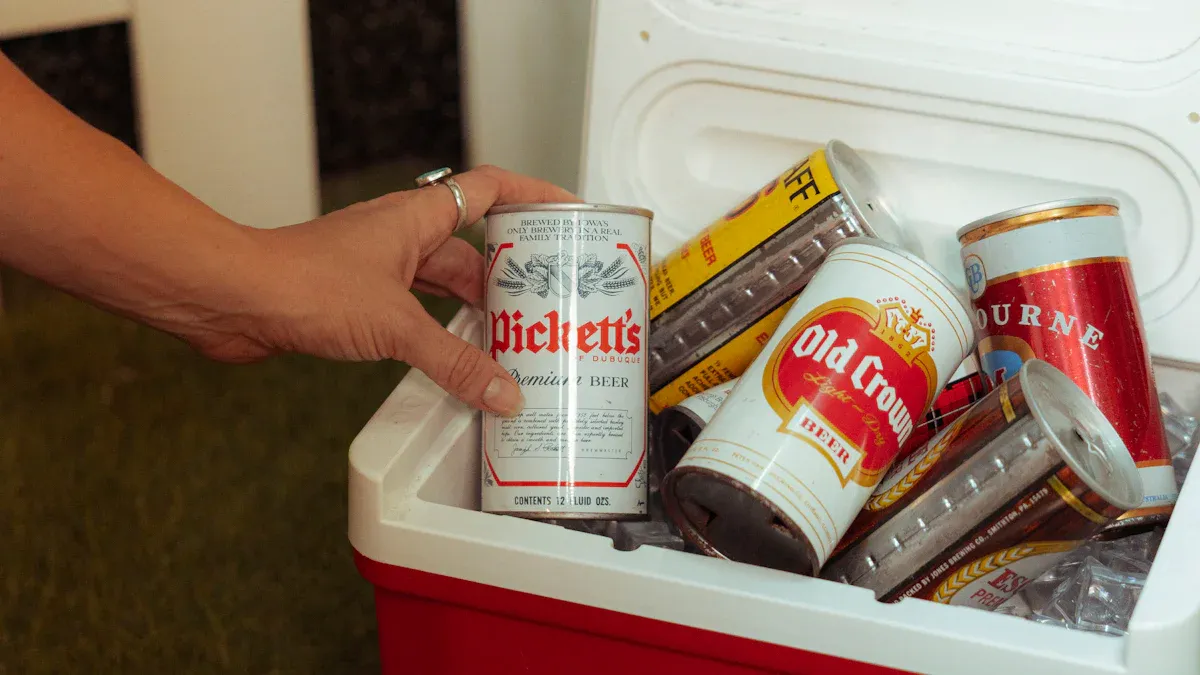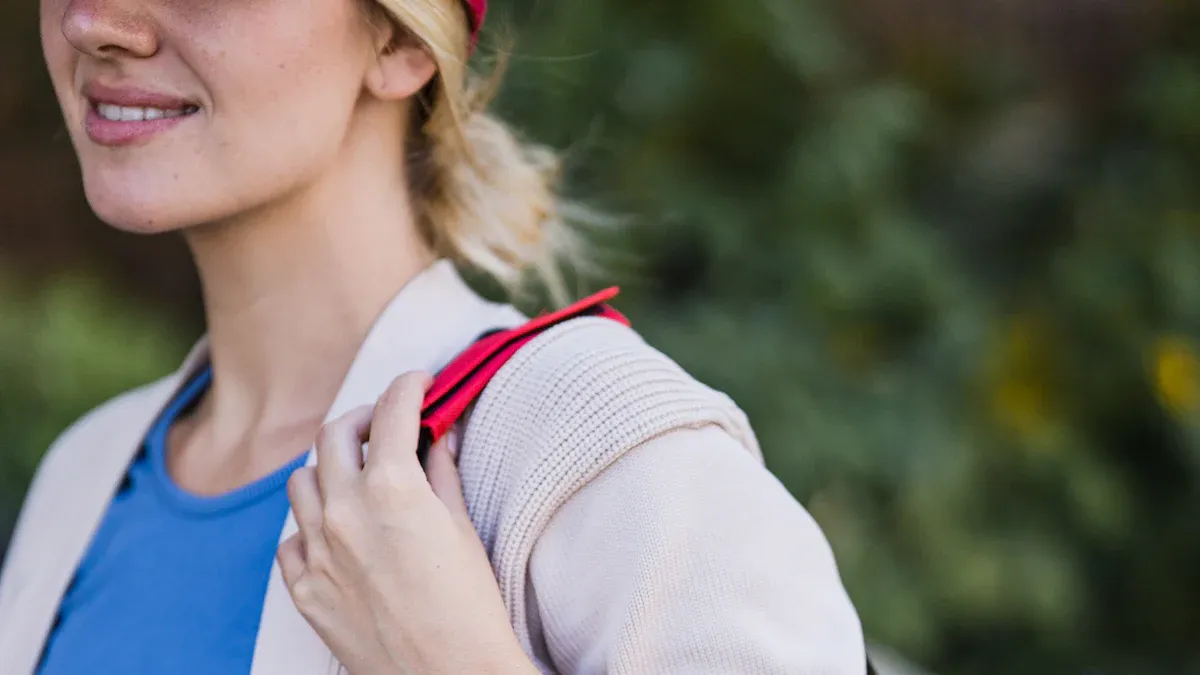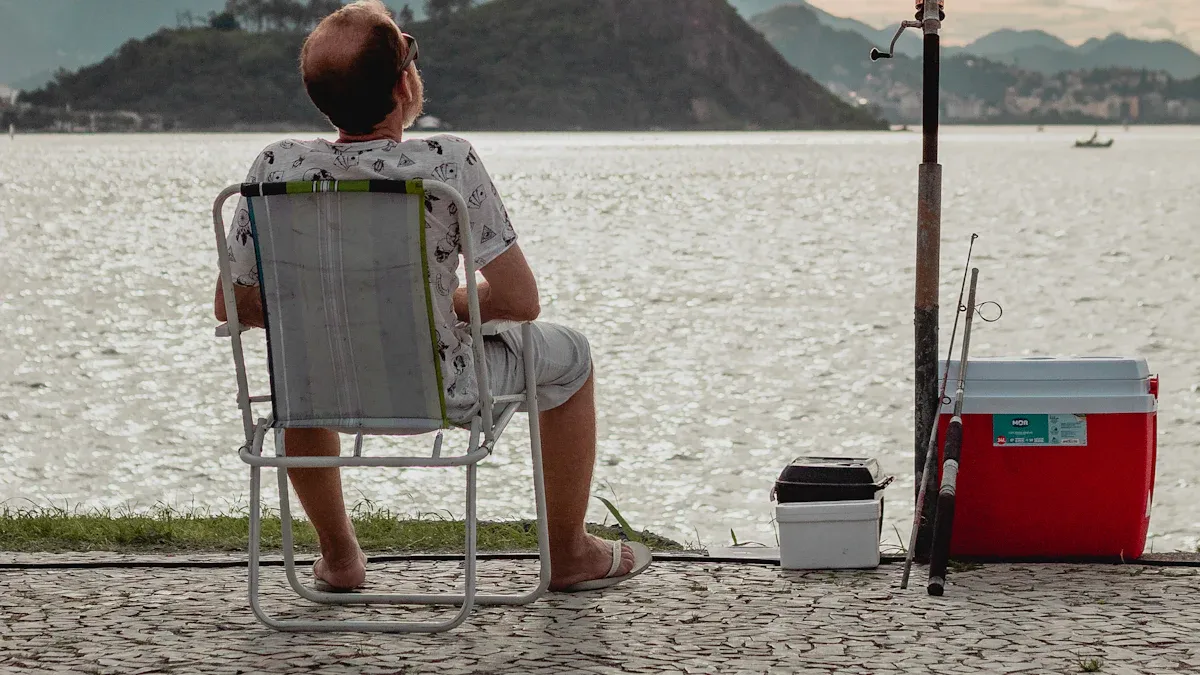
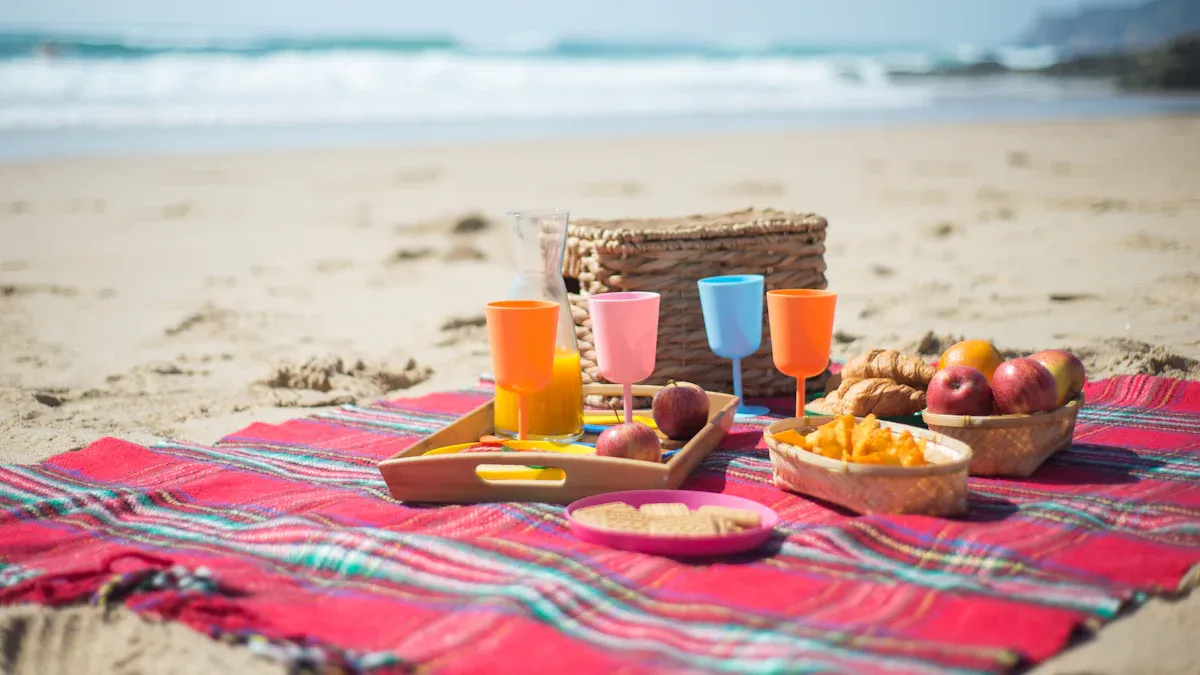
Choosing the right large ice box cooler depends on your group size and trip duration. For families or groups going on weekend trips, you need a cooler with a capacity between 55 and 75 quarts. If your group is larger or your adventure lasts several days, look for a large ice box cooler with 100 quarts or more for better ice retention and storage.
| Group Size / Trip Duration | Recommended Cooler Size (quarts) | Notes on Usage and Ice Ratio |
|---|---|---|
| Small groups or solo adventurers | 20-30 quarts | Suitable for day trips; lightweight and compact |
| Families or larger groups (weekend or 3-day trips) | 55-75 quarts | Provides enough capacity for extended camping; includes features like dividers |
| Large groups or extended expeditions | 100+ quarts | High capacity for professional or heavy-duty use; better ice retention |
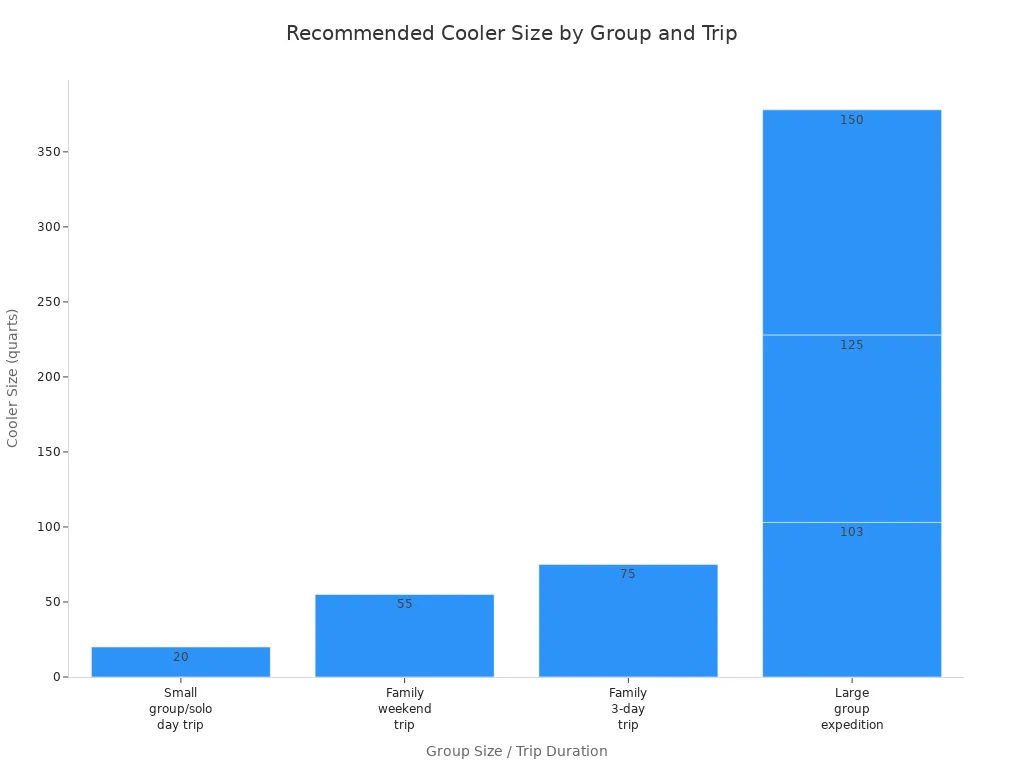
KUER stands out as a leader in cooler manufacturing. You benefit from their advanced research, strict quality control, and years of experience when you choose their products.
Large Ice Box Cooler Size Guide
Group Size and Trip Duration
When you plan an outdoor adventure, the number of people and the length of your trip determine your cooler size needs. You want a large ice box cooler that fits your group and keeps food and drinks cold for the entire journey. Use this cooler size guide to match your needs:
- Weekend Getaway (small groups): Choose a cooler around 35-55 quarts. This size works well for two to four people on a short trip.
- Family Camping Trip (3-day weekend): Pick a cooler in the 65-75 quart range. This size holds enough food, drinks, and ice for a family of four or five.
- Extended Expeditions (large groups): Select a large ice box cooler of 100 quarts or more. This size is best for groups of six or more on trips lasting several days.
| Group Size | Trip Duration | Typical Cooler Size Range (quarts) |
|---|---|---|
| 4-6 people | 2-3 days | 45-75 quarts |
| 6+ people | 3+ days | 110-250 quarts |
Tip: For longer trips, use a 2:1 ice-to-contents ratio. Fill two-thirds of your cooler with ice and one-third with food and drinks. This method helps maintain cold temperatures for several days.
Larger coolers are ideal for family gatherings, weekend camping, or tailgate parties. These coolers can hold up to 85 cans plus food and ice. Extra-large coolers, with capacities of 85-115 cans or more, support multi-day trips and bigger groups. You get better ice retention and more storage space, which means less worry about food safety.
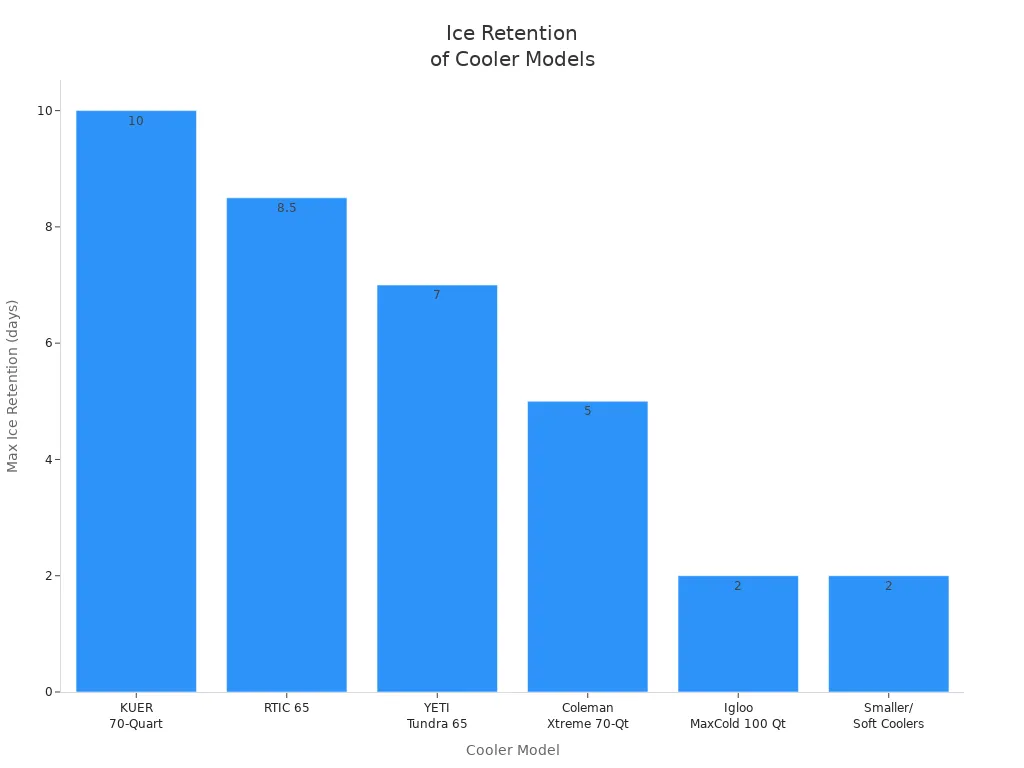
Storage Needs
Choosing the right size cooler for your group means thinking about what you need to store. You want enough room for meals, snacks, drinks, and ice. For a family of four on a two-day trip, you can use two smaller coolers of about 20 to 30 quarts each—one for food and one for drinks. This setup helps keep ice from melting quickly because you open each cooler less often.
For longer trips, a single large ice box cooler around 45 quarts or more is recommended. A 45-quart cooler can hold about 36 cans, plus ice and food. If you plan a week-long adventure or have a large group, look for cooler sizes in the 75-125 quart range. These large coolers offer better insulation and ice retention, keeping your supplies fresh for days.
- For short trips, smaller coolers are easier to carry.
- For multi-day outings, large coolers with wheels make transport simple.
- Always consider the weight of a fully loaded cooler. Some models can weigh 30 pounds or more, so wheels and sturdy handles are important.
KUER’s expertise in manufacturing large-capacity coolers ensures you get reliable performance. Their rotomolded coolers, like the KUER 70-Quart, offer ice retention for up to 10 days. Thick insulation, airtight seals, and rugged construction make these coolers perfect for families and groups. When you look for the best size cooler for a party or a camping trip, KUER’s advanced design and quality control give you peace of mind.
Use these recommendations to guide your choice. The cooler size guide helps you match cooler sizes to your group and trip duration. Choosing the right size cooler means you enjoy your adventure without worrying about spoiled food or warm drinks.
Why Size Matters
Ice Retention
When you choose a cooler for your family or group, ice retention becomes one of the most important factors. Larger coolers usually keep ice longer because they have more insulation and can hold more ice. You get better ice retention with coolers that use advanced technology, such as rotomolded construction and pressure-injected foam. These features help maintain cold temperatures for several days, even in hot weather.
Tip: For longer trips, pick a cooler that matches your group size and trip length. This ensures you get maximum ice retention and enough space for all your supplies.
If you select a cooler that is too small, you may need to cram food and drinks inside. This reduces air circulation and causes ice to melt faster. On the other hand, an oversized cooler adds extra weight and bulk, making it hard to carry on hikes or rough terrain. You want a cooler that balances capacity, portability, and ice retention. Managing the ice-to-content ratio, such as using a 1:1 ratio, helps you get the best results.
- Larger groups need bigger coolers for more food, drinks, and ice.
- Longer trips benefit from coolers that offer better ice retention.
- The right cooler size improves packing and keeps everything cold.
Cooler size influences ice retention, but insulation quality matters just as much. When you fill a large cooler with enough ice, you can expect maximum ice retention for your adventure.
Food Safety
Food safety depends on keeping your supplies cold for the entire trip. If you travel with a family or group, you need a cooler that holds enough food and ice to last several days. Coolers between 75 and 100 quarts work best for extended outings. These coolers provide space for perishable foods and help you avoid frequent ice replenishment.
High-quality hard-sided coolers with thick insulation and airtight seals keep ice for days. This protects your food from spoilage and keeps drinks fresh. Packing two coolers—one for food and one for drinks—helps maintain colder temperatures and makes it easier to access supplies.
- For multi-day trips, choose a cooler with at least 40 quarts.
- Pre-chill your cooler and freeze meat before packing to improve ice retention and food safety.
- The right cooler size depends on your group, trip length, and food type.
Selecting the proper cooler size ensures your food stays safe and fresh throughout your adventure.
Choosing the Right Cooler
Key Factors
When choosing the right cooler for your family or group, you need to look at several important factors. Each factor helps you get the best performance and value for your trip.
- Capacity: Start by thinking about how many people will join your trip and how long you will stay outdoors. For a weekend camping trip with four to six people, a 70-100 quart cooler works well. For larger groups or longer adventures, you may need a cooler with 100 quarts or more. Always use the 2:1 ice-to-content ratio for longer trips. This means you fill two-thirds of your cooler with ice and one-third with food and drinks.
- Insulation and Ice Retention: The quality of insulation makes a big difference. Thick walls and lids, sometimes up to 2.9 inches, keep your supplies cold for days. High-density foam and pressure-injected insulation help maintain low temperatures. A white cooler reflects sunlight, which can make ice last up to 20% longer than colored coolers.
- Portability: Large coolers can get heavy, especially when full. Look for sturdy handles, wheels, and a design that makes it easy to move your cooler over rough ground. Adjustable handles and wheels help you transport your cooler without strain.
- Durability: You want a cooler that can handle tough outdoor conditions. Rotational molding technology creates a one-piece, seamless cooler body. This design resists impacts and prevents leaks. Food-grade materials, UV resistance, and corrosion-proof parts add to the cooler’s lifespan.
- Additional Features: Some coolers come with dividers, tie-down points, built-in bottle openers, and bear-resistant certifications. These features make your cooler more useful and safer for outdoor adventures.
- Cooler Series Options: Different series, such as Outfitter, Adventure, Nomad, and Pro, offer unique sizes and features. You can pick a series that matches your group size and trip type.
Note: Choosing the right size cooler means you get enough space for your supplies and better ice retention. You also avoid carrying extra weight.
KUER uses advanced manufacturing to improve cooler performance. Their coolers have a three-layer structure: a tough outer shell, high-performance insulation, and a food-safe inner layer. The seamless, rotomolded build gives you extra strength and leak-proof protection. Features like airtight gaskets, stainless steel locks, and easy-drain valves make KUER coolers reliable for any group outing.
Activities and Use
The activities you plan will influence your choice when choosing the right cooler. Each activity has different needs for size, durability, and features.
| Group Size | Recommended Cooler Size (Quarts) | Typical Activities |
|---|---|---|
| 1-2 | 35-55 | Short trips, hiking, small picnics |
| 2+ | 55-75 | Small groups, extended weekends, car camping |
| 4-6 | 70-100 | Group camping, multi-day outings |
| 7+ | 100+ | Large groups, fishing, hunting, long trips |
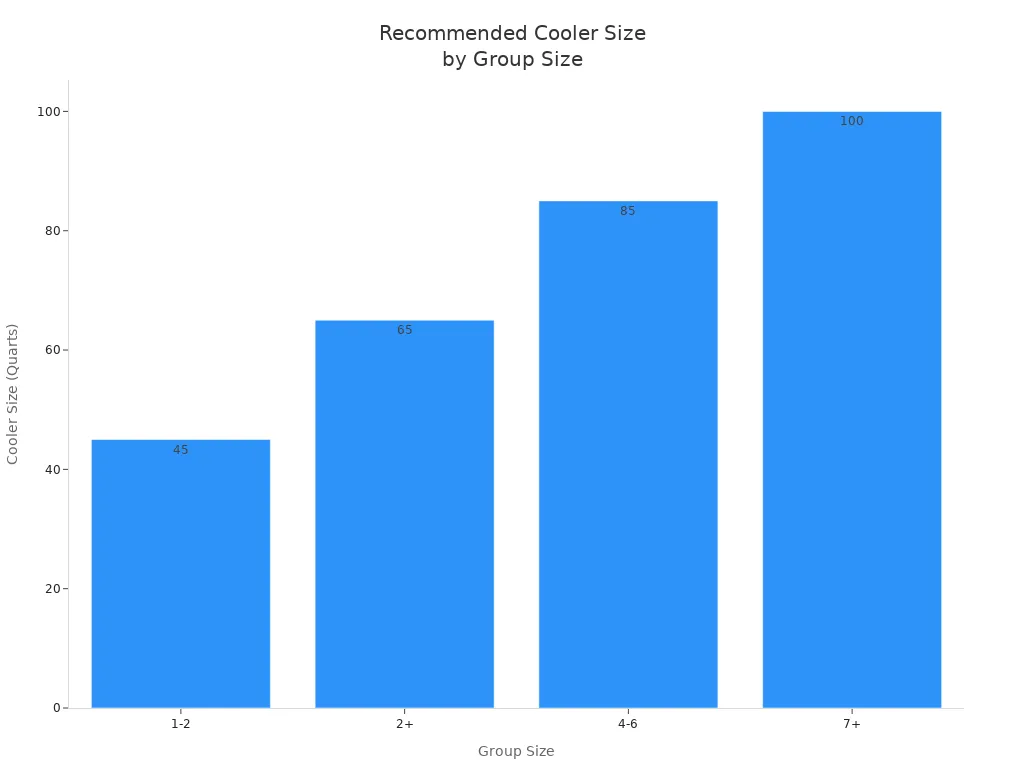
- Camping and Group Outings: For camping, you need a cooler with thick insulation and a rugged build. This keeps ice for several days and protects your food from wildlife. Hard-sided coolers work best for these trips.
- Fishing and Hunting: Choose an extra-large cooler with bear-proof certification and strong handles. You may need to store large catches or game, so durability and ice retention are key.
- Tailgating and Picnics: For tailgating, a cooler with built-in bottle openers and dividers adds convenience. Wheels and handles help you move the cooler across parking lots or fields.
- Hiking and Short Trips: For short hikes, a smaller, lighter cooler or cooler bag is easier to carry. These coolers work well for snacks and drinks on the go.
- RV and Car Camping: For RV trips, you may need a medium-sized cooler that fits in your vehicle. For car camping, a larger cooler gives you more storage for group meals.
Tip: Always consider how far you need to carry your cooler and where you will store it. Wheels and reinforced handles make a big difference for large groups or long walks.
KUER’s advanced manufacturing process ensures every cooler meets high standards. Rotational molding, thick insulation, and airtight seals keep your food safe and cold. Stainless steel locks, relief valves, and easy-drain plugs add to the cooler’s performance and ease of use. Certifications like SGS, CE, ISO9001, and FDA show KUER’s commitment to quality and safety.
When choosing the right size cooler, match your group size, trip duration, and planned activities. This approach helps you get the best results for every adventure.
Cooler Capacity Explained
Quarts and Cans
You often see cooler capacity measured in quarts or liters. Manufacturers also show how many standard 12-ounce cans a cooler can hold. This helps you compare cooler capacities and pick the right size for your group. For example, a 48-quart cooler can hold up to 72 cans. The Chill-Its 5171 Industrial Hard-Sided Cooler uses polyurethane foam insulation to keep items cold for up to 30 hours. It has heavy-duty rubber latches and a sealing gasket for better cooling.
One quart equals about 0.946 liters. A standard 12-ounce can holds 355 milliliters. If you pack 20 cans, you need about 7.5 quarts of space. Cooler capacity must also include room for ice. Most coolers use 30-50% of their volume for ice or ice packs. A cooler advertised as holding 20 cans usually has a total capacity between 16 and 21 quarts. The 20L Small Cooler, with a capacity of about 21.1 quarts, balances space for cans and ice. This design keeps your food and drinks cold and fresh.
Tip: Always check both the quart size and the can count when comparing cooler capacities. This helps you plan for enough space for ice and supplies.
Ice-to-Content Ratio
You need the right ice-to-content ratio to keep your cooler cold during group trips. The best ratio is two-thirds ice to one-third food and drinks. This means you fill most of your cooler with ice and leave space for your supplies. Frozen drinks or food also help maintain cold temperatures.
- Pack a layer of food, then a layer of ice. Repeat as needed.
- Use foldable ice sheets or wet frozen towels on top to trap cold air.
- Choose a cooler capacity that fits your group and trip length. Too small limits ice space. Too large creates air pockets that speed up warming.
- Block ice at the bottom and crushed ice in gaps help keep everything cold.
Maintaining a 2:1 ice-to-content ratio ensures your cooler stays cold for days. If you use less ice, temperatures rise quickly. More ice than this ratio does not improve cooling much. Proper cooler capacities let you pack enough ice and supplies for your adventure.
Features for Families and Groups
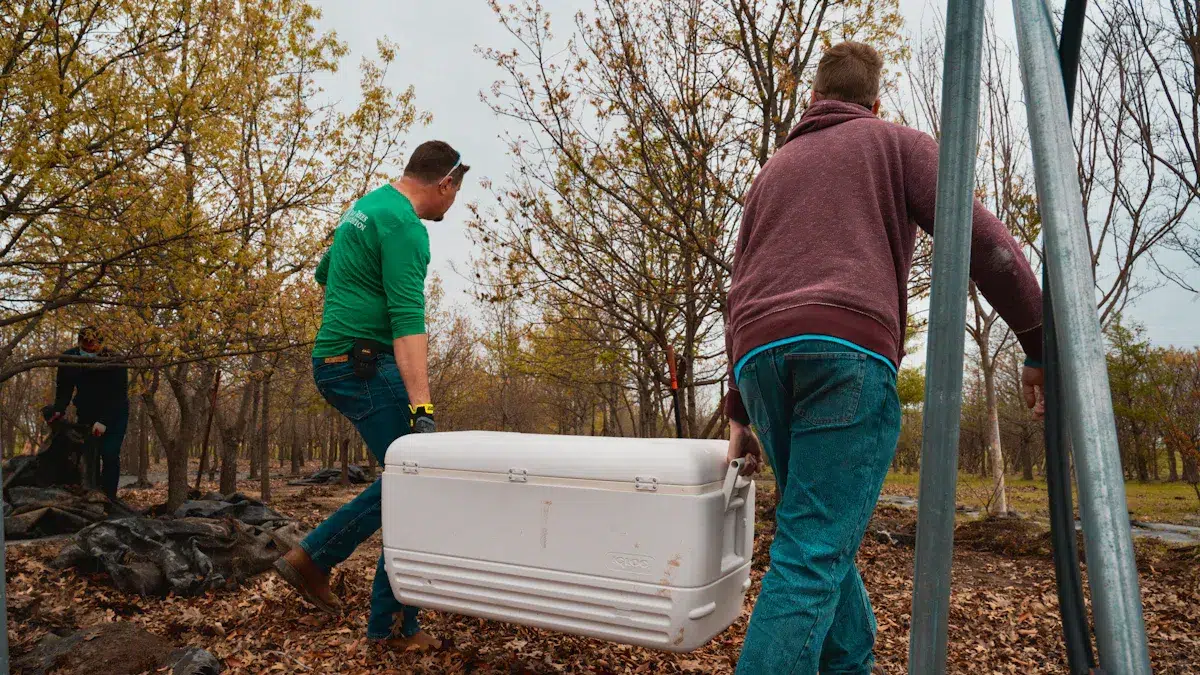
Insulation and Durability
When you choose a cooler for your family or group, you want it to keep ice for days and stand up to rough use. Polyurethane foam works best for insulation. This material fills every gap inside the cooler walls, creating a strong barrier that keeps cold air in and warm air out. Rotomolded construction uses high-density polyethylene to form thick, seamless walls. This method gives your cooler extra strength and impact resistance. Silicone or rubber gaskets around the lid create an airtight seal, which helps your cooler hold ice longer. Heavy-duty latches and UV-resistant coatings protect your cooler from sun damage and daily wear. You can trust a cooler with these features to last through many trips.
- Polyurethane foam insulation keeps ice for up to 10 days.
- Rotomolded bodies resist impacts and block UV rays.
- Airtight gaskets and strong latches lock in cold air.
Portability
A large cooler can get heavy, especially when filled with ice and drinks. You need a design that makes carrying easy. Many coolers for families and groups come with wide, molded handles that fit your hands. Some models add wheels with wide treads, so you can roll your cooler over grass, sand, or gravel. Backpack-style and soft-sided coolers let you carry supplies on your back, leaving your hands free. Fold-flat designs help you store your cooler when not in use. These features make it simple to move your cooler from your car to your campsite or picnic spot.
- Sturdy handles and wheels help you move heavy coolers.
- Backpack and soft-sided designs offer hands-free carrying.
- Fold-flat coolers save space during travel and storage.
Extra Features
Families and groups value coolers that offer more than just cold storage. Long-lasting ice retention, often 7 to 10 days, means you do not need to add ice often. Security features like dual latches, press-and-pull locks, and bear resistance keep your food safe outdoors. Many coolers include built-in bottle openers, non-slip feet, and tie-down slots for convenience. Some models have split lids for easy access or dividers to organize food and drinks. UV-resistant latches and marine-grade gaskets add to the cooler’s durability. Warranties, sometimes up to five years or more, give you peace of mind.
- Integrated bottle openers and non-slip feet add convenience.
- Bear-resistant locks and reinforced corners improve safety.
- Long warranties show the manufacturer’s confidence in their cooler.
Tip: Look for a cooler with features that match your group’s needs. The right combination of insulation, portability, and extras makes every outing easier and more enjoyable.
Hard-Sided vs. Soft-Sided Coolers
Pros and Cons
When you choose a cooler for your group, you need to think about the differences between hard-sided and soft-sided coolers. Each type has strengths and weaknesses. The table below helps you compare them:
| Aspect | Hard-Sided Coolers | Soft-Sided Coolers |
|---|---|---|
| Durability | Tough, long-lasting, handles rough use | Fabric can wear out, less durable over time |
| Ice Retention | Keeps ice for days, great insulation | Good for hours, but not for days |
| Capacity | Large, fits more food and drinks | Smaller, best for short trips |
| Portability | Heavy, bulky, harder to carry alone | Lightweight, easy to carry with straps |
| Storage | Rigid, takes up more space | Foldable, easy to store |
| Price | Costs more, but lasts longer | More affordable |
| Ideal Use | Big groups, long trips, tough conditions | Day trips, picnics, when you need to travel light |
Tip: If you want a cooler that lasts for years and keeps ice for a long time, pick a hard-sided cooler. If you need something light and easy to carry, a soft-sided cooler works best.
Best Uses
You should match your cooler to your activity. Hard-sided coolers work well for large groups and long adventures. You can use them for camping, fishing, hunting, or road trips. These coolers keep your food safe and cold, even in harsh places. They also protect your supplies from animals and rough weather.
Soft-sided coolers fit best with short outings. You can take them to a picnic, a sports game, or a day at the park. They are easy to carry and store. If you have a small group or need to walk far, a soft-sided cooler makes your trip easier.
-
Use a hard-sided cooler for:
- Multi-day camping with family or friends
- Tailgating and road trips
- Fishing or hunting in wild areas
-
Use a soft-sided cooler for:
- Day trips and picnics
- Sporting events or school outings
- Carrying lunch or snacks for a few people
You can choose the right cooler by thinking about your group size, trip length, and how much you need to carry. This helps you keep your food fresh and your trip fun.
Cooler Size Chart
Group Size vs. Capacity
Choosing the right cooler sizes for your group helps you keep food and drinks cold for the whole trip. You want to match the number of people in your group to the right cooler capacity. This makes packing easier and keeps everything fresh.
Here is a table that shows how different cooler sizes fit different group needs:
| Cooler Size Category | Can Capacity Range | Typical Use Case / Group Size |
|---|---|---|
| Small Coolers | 6 – 30 cans | Quick trips, kids’ sports games, picnics, beach days (small groups or short outings) |
| Medium Coolers | Up to 45 cans | Day-long outings, tailgating, family picnics, fishing trips (small to medium groups) |
| Large Coolers | Up to 115 cans | Weekend camping trips, large gatherings, multi-day excursions, boat trips (medium to large groups) |
You can see that small coolers work best for one or two people. Medium cooler sizes fit a family or a small group for a day trip. Large cooler sizes give you enough space for big groups or longer adventures.
If you want more details, look at this table with popular cooler models and their capacities:
| Cooler Model | Approximate Can Capacity | Pounds of Ice Capacity | Bottles of Wine Capacity |
|---|---|---|---|
| Roadie 15 | 22 cans | 16 lbs | 7 bottles |
| Roadie 24 | 33 cans | 26 lbs | 8 bottles |
| Roadie 32 | 50 cans | 36 lbs | 14 bottles |
| Roadie 48 | 76 cans | 54 lbs | 15 bottles |
| Roadie 60 | 98 cans | 68 lbs | 19 bottles |
| Tundra 35 | 39 cans | 29 lbs | N/A |
| Tundra 45 | 54 cans | 37 lbs | N/A |
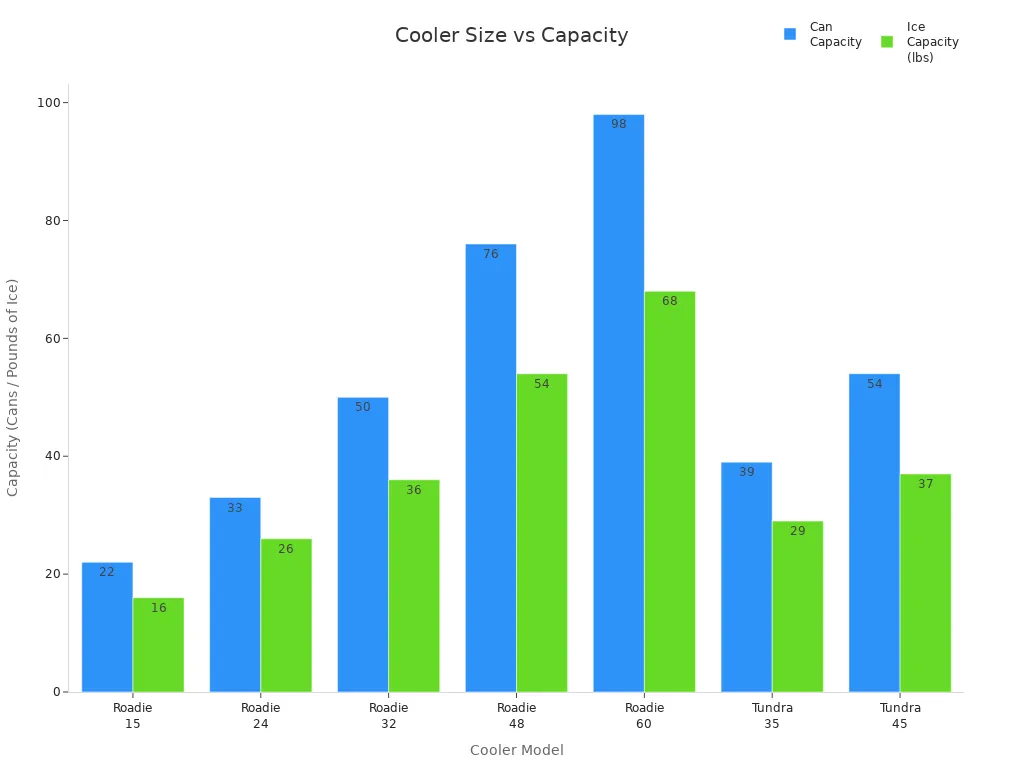
Tip: Always check the can capacity and ice capacity when you compare cooler sizes. This helps you pick the best cooler for your group and your trip.
When you plan your next outing, use these cooler sizes to make sure you have enough space for everyone’s food and drinks. The right cooler sizes keep your supplies cold and your group happy.
Tips for Choosing the Right Cooler
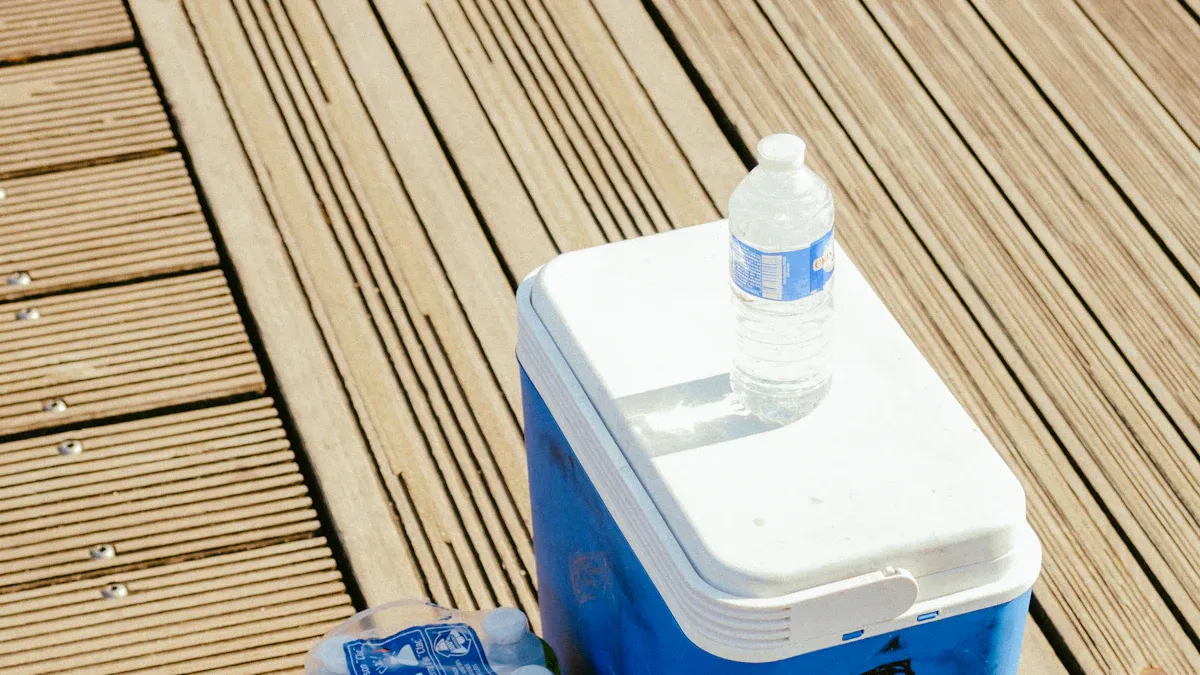
Matching Needs
Selecting the best cooler for your family or group starts with understanding your needs. You want to match the size and features to your group size, trip duration, and planned activities. Here are some practical tips to help you make the right choice:
- Pick the cooler size based on your group and trip length. Small coolers (up to 20 quarts) work for solo or short trips. Medium sizes (20-50 quarts) fit small groups or weekends. Large coolers (50-75 quarts) suit families or longer outings. Extra-large models (75+ quarts) are best for big groups or extended adventures.
- Think about your activity. Fishing trips may need extra space for your catch. Camping or tailgating often requires more storage and better insulation.
- Balance capacity with portability. Large coolers can get heavy. Look for wheels or sturdy handles to make moving them easier.
- Prioritize ice retention. For multi-day trips, choose a cooler with thick insulation and a tight seal to keep contents cold.
- Organize your supplies. Removable baskets, dividers, and shelves help you pack food and drinks efficiently.
- Test pack your cooler before your trip. Make sure everything fits comfortably.
- Choose extra features like bear resistance and strong construction for safety and durability.
Tip: Clean your cooler after every use. Use mild soap and warm water. For tough stains, try baking soda or vinegar. Dry the cooler completely before storing it to prevent mold and odors.
KUER Recommendations
KUER stands out for its advanced manufacturing and strong research and development. The company produces up to 1,500 cooler boxes daily and holds over 50 patents. KUER’s large rotomolded coolers, such as the KUER-B and KUER-C models, offer spacious interiors with dividers for easy organization. These models work well for family gatherings, barbecues, and long trips. The KUER-D model focuses on portability with removable nylon handles and a lightweight build, making it great for daily use or beach outings. KUER-F is designed for fishing and long-term cold storage, using high-density insulation to keep items cool for up to eight days.
All KUER coolers use durable materials and rotomolding technology for strength and leak-proof performance. Features like customizable dividers, drain valves, and stainless steel locks add convenience. KUER’s customer support includes a five-year warranty for incubators, strict quality control, and a professional after-sales team. You receive fast shipping, free design services, and reliable help whenever you need it.
Note: KUER’s recommendations focus on quality, innovation, and customer satisfaction, making their coolers a smart choice for families and groups.
To choose the best large ice box cooler for your family or group, follow these steps:
- Check your group size and trip length to pick the right cooler size.
- Plan your meals and storage needs for better organization.
- Select a cooler with strong insulation and sturdy construction.
- Make sure the cooler is easy to carry and fits your space.
- Look for helpful features like dividers or tie-down points.
- Pack your cooler with two-thirds ice and one-third food for best results.
KUER coolers stand out with advanced insulation, durable materials, and many size options. Their global factories and strict quality control ensure you get reliable products and great service.
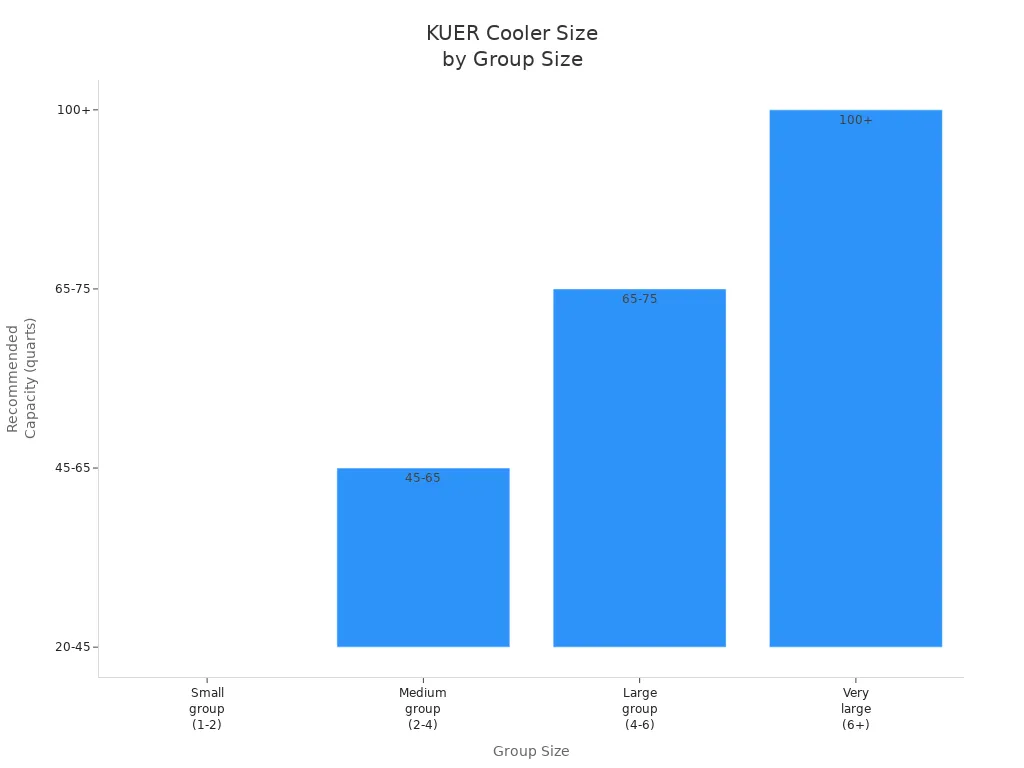
Explore KUER’s coolers to keep your group’s food fresh and drinks cold on every adventure.
FAQ
What size cooler do you need for a family camping trip?
You need a cooler between 65 and 75 quarts for a family of four or five on a weekend camping trip. This size holds enough food, drinks, and ice for two to three days.
How long can a large ice box cooler keep ice?
A high-quality large cooler, like those from KUER, can keep ice for up to 10 days. You get the best results when you pre-chill the cooler and use a 2:1 ice-to-content ratio.
Can you use one cooler for both food and drinks?
You can use one large cooler for both, but using two coolers—one for food and one for drinks—helps keep ice longer. Opening the cooler less often keeps the inside colder and your food safer.
What features should you look for in a group cooler?
Look for thick insulation, strong handles, wheels, airtight seals, and extra features like dividers or bottle openers. These features make your cooler easier to use and help keep your supplies cold and organized.


